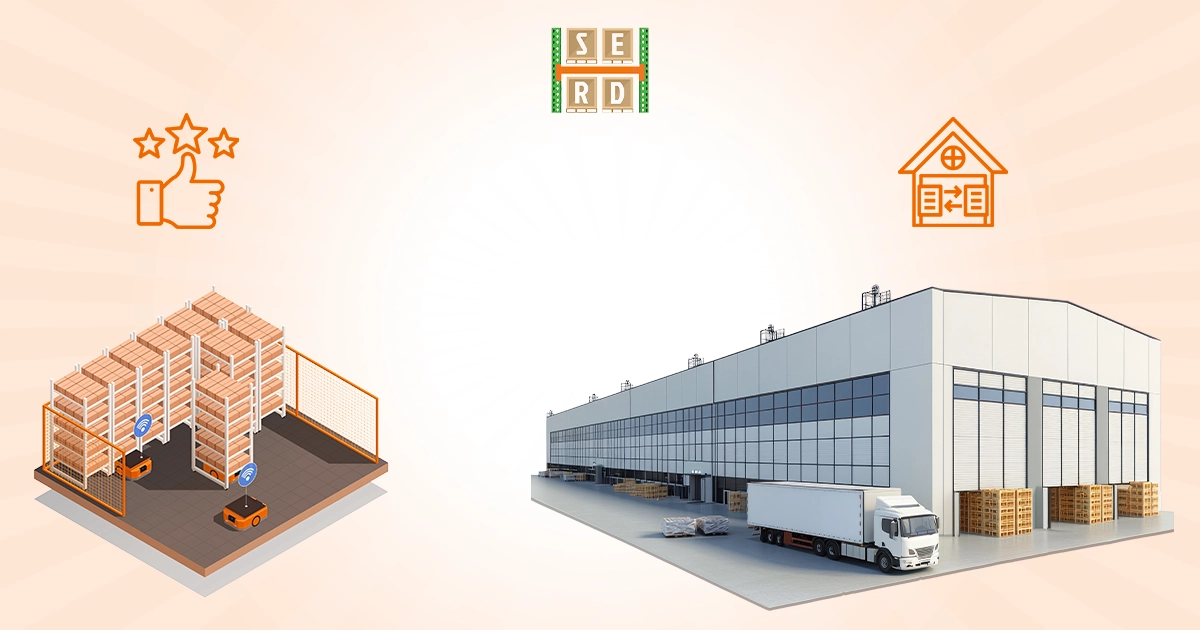


The Impact of Smart Warehouse Design Consultation on Efficiency and Cost Savings.
Smart warehouse design consultation is a business strategic investment that boosts efficiency, reduces operational costs, and stays competitive in an industry. A well-planned smart warehouse design can significantly enhance efficiency and lead to substantial cost savings. Smart warehouse efficiency consulting not only improves the physical layout and efficiency of operations but also integrates advanced technology and smart strategies to enhance cost-saving measures. Here’s how it impacts both:
- Space optimization: Smart design ensures optimal use of available space by incorporating vertical storage solutions like pallet racks and mezzanines. Optimizing warehouse layout reduces the need for facility expansion and minimizes real estate costs.
- Improved workflow efficiency: By strategically placing storage, workstations, and loading docks, warehouses can minimize travel time for workers and equipment. Automation, such as conveyor systems and robotics, further enhances productivity.
- Enhanced inventory management: With real-time tracking through warehouse management systems (WMS), businesses can reduce stock discrepancies, prevent overstocking, and improve order accuracy, leading to better cost control.
- Energy efficiency: Smart lighting, insulation, and climate control solutions reduce energy consumption, lowering operational expenses while ensuring a comfortable and safe work environment.
- Reduced labor costs: Automation, including autonomous forklifts and pick-and-place systems, reduces the need for manual labor, improving safety and cutting long-term labor expenses.
- Faster order fulfillment: A well-organized layout combined with automated picking and packing processes speeds up order fulfillment, enhancing customer satisfaction and reducing costs associated with delays.
- Improved safety and compliance: A smart design integrates safety measures like designated walkways, fire suppression systems, and ergonomic workstations, reducing workplace injuries and compliance-related expenses.

How Data-Driven Layout Planning Enhances Productivity?
Data-driven layout planning significantly enhances storage facility design in several ways by optimizing the use of space and resources. Using data for industrial storage planning can achieve more efficient workflows, lower costs, and increased throughput, all of which contribute to higher productivity. Here’s how it works:
- Efficient space utilization: By analyzing historical data and understanding workflow patterns, a data-driven approach can help design layouts that maximize available space. This reduces wasted space and allows for better storage, easy access to materials, and efficient traffic flow.
- Improved workflow: Data can reveal inefficiencies in existing workflows. By using real-time information (such as inventory levels, worker movement patterns, or production times), planners can design layouts that minimize unnecessary steps or travel, leading to faster operations.
- Optimized resource allocation: Analyzing performance data allows companies to identify bottlenecks or areas of underutilized resources. With this knowledge, layouts can be adjusted to ensure that labor, machinery, and equipment are allocated where they’re needed most.
- Enhanced flexibility and scalability: As businesses grow, their layout needs can change. Data-driven planning allows for flexible layouts that can be easily adjusted based on trends in production demand, seasonal shifts, or new technologies.
- Predictive maintenance: Data analytics can track equipment usage and performance, helping predict when machines need maintenance. This prevents unexpected downtimes, ensuring smooth operations.
- Cost savings: By improving efficiency and reducing wasted space, time, and resources, data-driven layouts can lead to significant cost savings in labor, energy, and material handling.
- Safety improvements: Data-driven planning considers safety factors by analyzing accident trends, optimizing the placement of safety equipment, and ensuring that safety protocols are adhered to, reducing risk and enhancing overall productivity.
Not Sure about what you need?
Contact a pro- Recent Posts
- Popular Posts
- Carpet Racks That Maximize Space: What Every Dealer Needs
- Timber Racking Systems for Safe Lumber Storage
- Selective Pallet Rack for Efficient Warehouse Storage
- Drive-In Pallet Rack Systems for Georgia Warehouses
- Heavy Duty Racks: Durable, High-Capacity Industrial Storage
- Selective Pallet Rack for Efficient Warehouse Storage
- Carpet Racks That Maximize Space: What Every Dealer Needs
- Timber Racking Systems for Safe Lumber Storage
- Warehouse Installation and Relocation: A Step-by-Step Guide for a Seamless Transition.
- The Impact of Smart Warehouse Design Consultation on Efficiency and Cost Savings.



